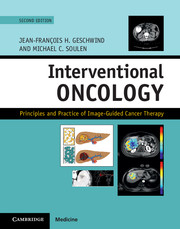Book contents
- Frontmatter
- Contents
- List of contributors
- Section I Principles of oncology
- Section II Principles of image-guided therapies
- Section III Organ-specific cancers – primary liver cancers
- Section IV Organ-specific cancers – liver metastases
- Section V Organ-specific cancers – extrahepatic biliary cancer
- Section VI Organ-specific cancers – renal cell carcinoma
- Section VII Organ-specific cancers – chest
- Section VIII Organ-specific cancers – musculoskeletal
- Section IX Organ-specific cancers – prostate
- Section X Specialized interventional techniques in cancer care
- 28 Vascular access: Venous and arterial ports
- 29 Palliative care and symptom management
- 30 CT-guided neurolysis for cancer-related abdominal and pelvic pain
- 31 Palliative procedures for ascites and effusion
- Index
- References
30 - CT-guided neurolysis for cancer-related abdominal and pelvic pain
from Section X - Specialized interventional techniques in cancer care
Published online by Cambridge University Press: 05 September 2016
- Frontmatter
- Contents
- List of contributors
- Section I Principles of oncology
- Section II Principles of image-guided therapies
- Section III Organ-specific cancers – primary liver cancers
- Section IV Organ-specific cancers – liver metastases
- Section V Organ-specific cancers – extrahepatic biliary cancer
- Section VI Organ-specific cancers – renal cell carcinoma
- Section VII Organ-specific cancers – chest
- Section VIII Organ-specific cancers – musculoskeletal
- Section IX Organ-specific cancers – prostate
- Section X Specialized interventional techniques in cancer care
- 28 Vascular access: Venous and arterial ports
- 29 Palliative care and symptom management
- 30 CT-guided neurolysis for cancer-related abdominal and pelvic pain
- 31 Palliative procedures for ascites and effusion
- Index
- References
Summary
Introduction
Cancer-related abdominal and pelvic pain is unfortunately common. For instance, up to 70–80% of patients with pancreatic cancer suffer from substantial pain. The treatment of cancer-related pain is challenging, with systemic analgesic therapy being, in general, the first-line treatment.
Unfortunately, for up to one-third of patients with pancreatic cancer, pain is not well controlled by such analgesics. Compounding this challenge is the side-effect profile of opiates – including nausea, vomiting, constipation, and sedation – that can paradoxically degrade quality of life. Managing cancer-related pain refractory to such analgesic therapy requires additional strategies that demand a multidisciplinary approach, including surgery, radiation oncology, pain medicine, and interventional radiology.
Image-guided neurolysis represents an important strategy in battling cancer-related abdominal and pelvic pain. Celiac plexus neurolysis (CPN) is the most common type and can be a very effective adjunctive therapy; it may have a lasting effect in 70–90% of patients with pain related to abdominal malignancy. The keys to treatment success with image-guided neurolysis are to: (1) review cross-sectional imaging, usually computed tomography (CT); (2) understand the relevant anatomy; (3) inject sufficient volume of neurolytic agent; and (4) ensure adequate spread of neurolytic agent.
Although the terms have been used interchangeably, a neurolysis procedure should be distinguished from a “block.” Neurolysis refers to permanent disruption of neural pathways that mediate pain, usually with agents such as ethanol or phenol, whereas a block refers to temporary disruption with local anesthetics or steroids. Neurolytic effects, however, may last no more than 3–6 months due to neural regeneration and tumor growth.
Ethanol at a 95–100% concentration is a commonly used neurolytic agent. One disadvantage is transient pain experienced during instillation; lidocaine or bupivacaine may be instilled first or mixed with ethanol to reduce intraprocedural pain. Alternatively, phenol may be used as a neurolytic agent. It has a local anesthetic effect and so intraprocedural pain is less common. However, it is a less potent neurolytic and is more viscous than ethanol, which limits mixing with contrast material. As such, ethanol is the more commonly used agent.
Various modalities for imaging guidance have been described, including fluoroscopy, CT, and endoscopic ultrasound. CPN may be performed using CT guidance or CT fluoroscopy given the excellent delineation of anatomic structures as well as spread of contrast agent afforded by CT at the time of neurolysis.
- Type
- Chapter
- Information
- Interventional OncologyPrinciples and Practice of Image-Guided Cancer Therapy, pp. 315 - 322Publisher: Cambridge University PressPrint publication year: 2016



